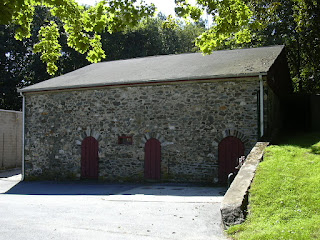 |
| Samuel P. Dixon House, 1986 |
Although from the front (not including the new large addition on the far side, not shown in the picture above) the house looks like one uniform structure, it was actually built in two stages, probably in succeeding generations. The original section (the left half in the picture above) was built about 1791, and was a two-bay, single room plan common among Quakers of the time. Several decades later, likely by the son of the original builder, the western addition was added, effectively doubling the size of the house.
Originally, the two first floor center bays were doorways, but at some point the left one was partially filled and converted into a window. Besides the fact that the windows are not evenly spaced across the front, the divide between the sections is also apparent from the slightly different colored stones used. Much more recently, in the 1990's, a large perpendicular addition was built on the east end of the house (away from the road). Great care was apparently given in having the new section blend with the older house. The stone used blends seamlessly from the old sections to the new. Frankly, if there were not an older (pre-addition) picture, I would wonder why the National Register of Historic Places form from 1986 never mentioned it.
 |
| Newer view of the front of the house |
So it was Jehu Dixon who built the original section of the house, which according to Runk's Biographical and Genealogical History of the State of Delaware, he did in 1791. I don't know that this date is corroborated archaeologically, but the style of the house is consistent with that era. After Jehu's death in 1807, his wife, Mary Taylor Dixon, continued to work the farm, presumably with the help of family or hired farm hands. Jehu and Mary's only living son, Samuel P. Dixon (1800-1879), eventually took over the farm, and lived there the rest of his life.
 |
| Samuel P. Dixon's c.1830 stone barn |
Samuel P. Dixon, it seems likely, was the one responsible for the first addition to the house, probably in the later 1820's. It was also at about this same time that Samuel erected the beautiful stone barn that still graces the property. And not only was he a successful farmer, but he was politically involved in the community, too, serving two terms on the Levy Court of New Castle County. (The Levy Court was an elected body charged with raising and disbursing tax money in the county -- somewhat of a forerunner of the County Counsel.) Sometime around 1822, Samuel married Mary Beeson, with whom he would have nine children. Their seventh child, and first son, was Samuel C., born in 1837.
Samuel C. Dixon (1837-1910) was born on the family farm and would eventually die there, but for most of a thirty year stretch in between he would venture out of Mill Creek Hundred. In 1859, Samuel C. moved to Coatesville, PA to join his brother William in business making farm implements. At the outbreak of the Civil War in 1861, he enlisted in the Seventh Pennsylvania Cavalry, with whom he would remain until nearly six months after the end of the war, in 1865. He was wounded several times, captured once, and promoted all the way to Captain. His regiment took part in numerous major battles, as well as accompanying Gen. Sherman on his march to Atlanta. Runks has an even more detailed account of Dixon's service, which seems to be enough to make a movie out of.
After leaving the army, Samuel C. returned home for a couple of years to work the family's farm along with his father. In 1867 he moved to North Carolina to run a lumber business in which he had heavily invested, and which three years later folded, taking with it his entire fortune. He then came back north, and took work in Kennett Square as a carpenter, later moving to Wilmington to work for Jackson and Sharp, presumably doing carpentry on railroad cars. In 1888, Samuel finally came home to Ashland to run the family farm again, which his three sisters had been doing for the previous nine years following Samuel P.'s death.
Samuel C. Dixon remained on the farm after his wife Ella passed away in 1892. In 1900, Samuel was still running the farm, along with the help of several of his children. By the 1910 census (completed just months before his death), it appears that he's still on the farm, but his son-in-law Samuel Way (married to daughter Mary) is the Head of Household. I couldn't find the Ways in 1920, but in 1930 they lived just to the east in Christiana Hundred, on Owls Nest Road. It seem that the the old house, built by Samuel C. Dixon's grandfather Jehu, may have passed out of the family's hand upon his death in 1910. By the look of it now, the subsequent owners took excellent care of the property, up to and including the recent addition. The circa 1791 house and 1830 stone barn look as great today as they did generations ago when the Dixons worked the land.
Additional Facts and Related Thoughts:
- There doesn't seem to be a consensus about the facts relating to Isaac Dixon. To me, it makes more sense that he's the son of John Dixon of Hockessin, but Runks states that he was born in New Castle, and lived in Christiana Hundred. However, I know there are readers of this site who have access to more Friends records and/or have distant connections to the Dixons. Maybe we can finally settle this for certain.
- The Dixons were all Friends up through Samuel P.'s generation, and were buried at the Hockessin Meeting House. Samuel C., however, was a Presbyterian and is intered with his wife at the Union Hill Cemetery in Kennett Square, her hometown.
